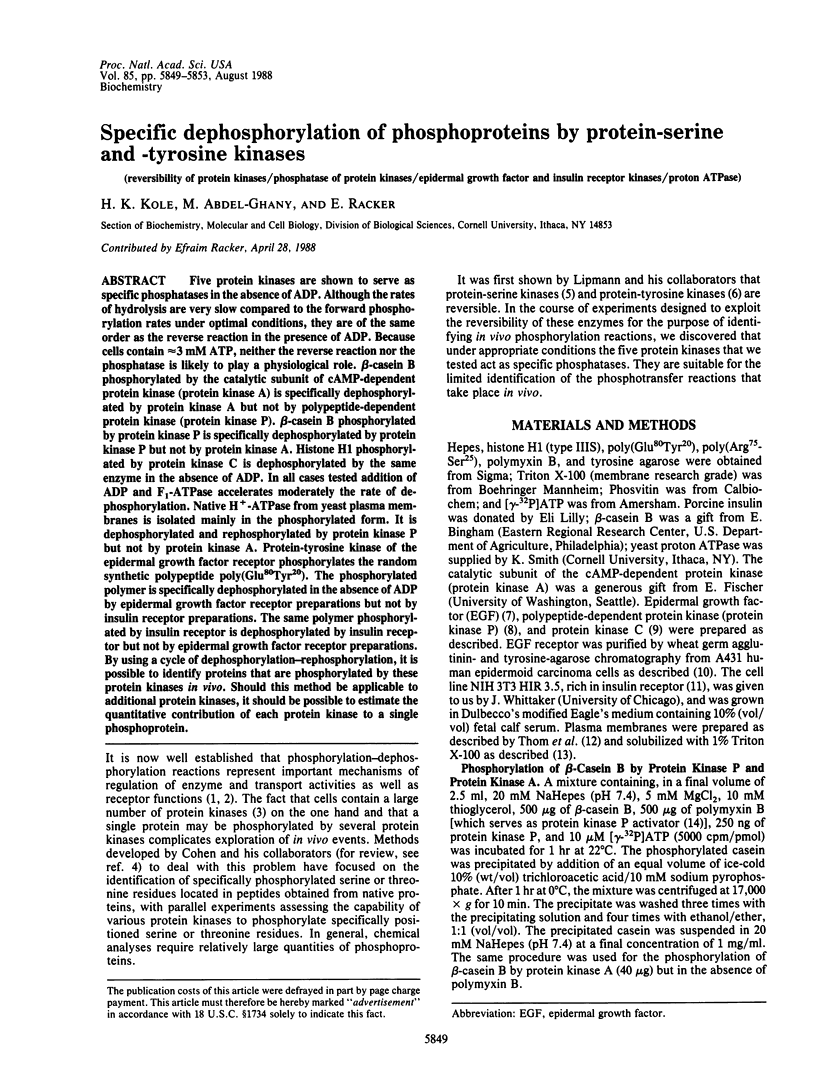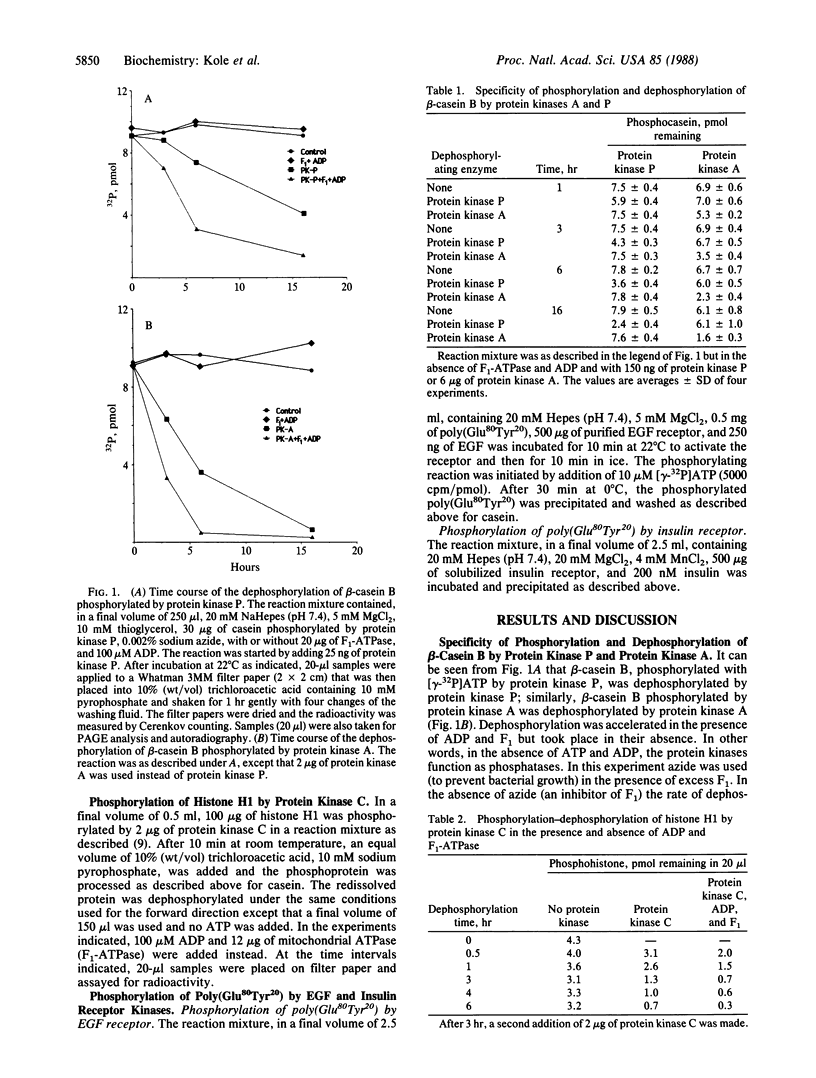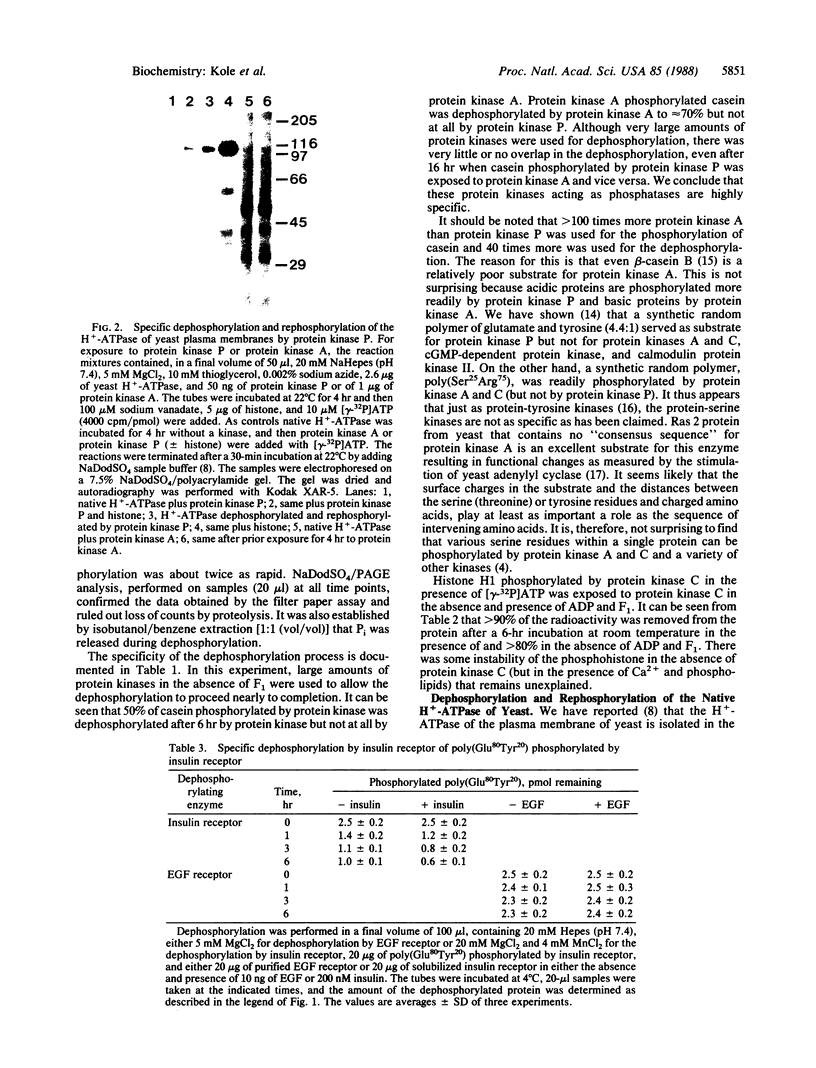Abstract
Five protein kinases are shown to serve as specific phosphatases in the absence of ADP. Although the rates of hydrolysis are very slow compared to the forward phosphorylation rates under optimal conditions, they are of the same order as the reverse reaction in the presence of ADP. Because cells contain approximately equal to 3 mM ATP, neither the reverse reaction nor the phosphatase is likely to play a physiological role. beta-casein B phosphorylated by the catalytic subunit of cAMP-dependent protein kinase (protein kinase A) is specifically dephosphorylated by protein kinase A but not by polypeptide-dependent protein kinase (protein kinase P). beta-casein B phosphorylated by protein kinase P is specifically dephosphorylated by protein kinase P but not by protein kinase A. Histone H1 phosphorylated by protein kinase C is dephosphorylated by the same enzyme in the absence of ADP. In all cases tested addition of ADP and F1-ATPase accelerates moderately the rate of dephosphorylation. Native H+-ATPase from yeast plasma membranes is isolated mainly in the phosphorylated form. It is dephosphorylated and rephosphorylated by protein kinase P but not by protein kinase A. Protein-tyrosine kinase of the epidermal growth factor receptor phosphorylates the random synthetic polypeptide poly(Glu80Tyr20). The phosphorylated polymer is specifically dephosphorylated in the absence of ADP by epidermal growth factor receptor preparations but not by insulin receptor preparations. The same polymer phosphorylated by insulin receptor is dephosphorylated by insulin receptor but not by epidermal growth factor receptor preparations. By using a cycle of dephosphorylation-rephosphorylation, it is possible to identify proteins that are phosphorylated by these protein kinases in vivo. Should this method be applicable to additional protein kinases, it should be possible to estimate the quantitative contribution of each protein kinase to a single phosphoprotein.
Full text
PDF




Images in this article
Selected References
These references are in PubMed. This may not be the complete list of references from this article.
- Abdel-Ghany M., Raden D., Racker E., Katchalski-Katzir E. Phosphorylation of synthetic random polypeptides by protein kinase P and other protein-serine (threonine) kinases and stimulation or inhibition of kinase activities by microbial toxins. Proc Natl Acad Sci U S A. 1988 Mar;85(5):1408–1411. doi: 10.1073/pnas.85.5.1408. [DOI] [PMC free article] [PubMed] [Google Scholar]
- Akiyama T., Kadooka T., Ogawara H. Purification of the epidermal growth factor receptor by tyrosine-Sepharose affinity chromatography. Biochem Biophys Res Commun. 1985 Aug 30;131(1):442–448. doi: 10.1016/0006-291x(85)91822-4. [DOI] [PubMed] [Google Scholar]
- Bingham E. W., Groves M. L., Szymanski E. S. Phosphorylation of casein by cyclic AMP-dependent protein kinase. Biochem Biophys Res Commun. 1977 Feb 21;74(4):1332–1339. doi: 10.1016/0006-291x(77)90588-5. [DOI] [PubMed] [Google Scholar]
- Braun S., Abdel Ghany M., Lettieri J. A., Racker E. Partial purification and characterization of protein tyrosine kinases from normal tissues. Arch Biochem Biophys. 1986 Jun;247(2):424–432. doi: 10.1016/0003-9861(86)90602-8. [DOI] [PubMed] [Google Scholar]
- Braun S., Raymond W. E., Racker E. Synthetic tyrosine polymers as substrates and inhibitors of tyrosine-specific protein kinases. J Biol Chem. 1984 Feb 25;259(4):2051–2054. [PubMed] [Google Scholar]
- El-Maghrabi M. R., Pate T. M., Pilkis J., Pilkis S. J. Effect of sulfhydryl modification on the activities of rat liver 6-phosphofructo-2-kinase/fructose-2,6-bisphosphatase. J Biol Chem. 1984 Nov 10;259(21):13104–13110. [PubMed] [Google Scholar]
- Fukami Y., Lipmann F. Reversal of Rous sarcoma-specific immunoglobulin phosphorylation on tyrosine (ADP as phosphate acceptor) catalyzed by the src gene kinase. Proc Natl Acad Sci U S A. 1983 Apr;80(7):1872–1876. doi: 10.1073/pnas.80.7.1872. [DOI] [PMC free article] [PubMed] [Google Scholar]
- Hunter T. A thousand and one protein kinases. Cell. 1987 Sep 11;50(6):823–829. doi: 10.1016/0092-8674(87)90509-5. [DOI] [PubMed] [Google Scholar]
- LaPorte D. C., Koshland D. E., Jr A protein with kinase and phosphatase activities involved in regulation of tricarboxylic acid cycle. Nature. 1982 Dec 2;300(5891):458–460. doi: 10.1038/300458a0. [DOI] [PubMed] [Google Scholar]
- Navarro J., Abdel Ghany M., Racker E. Inhibition of tyrosine protein kinases by halomethyl ketones. Biochemistry. 1982 Nov 23;21(24):6138–6144. doi: 10.1021/bi00267a018. [DOI] [PubMed] [Google Scholar]
- RABINOWITZ M., LIPMANN F. Reversible phosphate transfer between yolk phosphoprotein and adenosine triphosphate. J Biol Chem. 1960 Apr;235:1043–1050. [PubMed] [Google Scholar]
- Resnick R. J., Racker E. Phosphorylation of the RAS2 gene product by protein kinase A inhibits the activation of yeast adenylyl cyclase. Proc Natl Acad Sci U S A. 1988 Apr;85(8):2474–2478. doi: 10.1073/pnas.85.8.2474. [DOI] [PMC free article] [PubMed] [Google Scholar]
- Savage C. R., Jr, Cohen S. Epidermal growth factor and a new derivative. Rapid isolation procedures and biological and chemical characterization. J Biol Chem. 1972 Dec 10;247(23):7609–7611. [PubMed] [Google Scholar]
- Thom D., Powell A. J., Lloyd C. W., Rees D. A. Rapid isolation of plasma membranes in high yield from cultured fibroblasts. Biochem J. 1977 Nov 15;168(2):187–194. doi: 10.1042/bj1680187. [DOI] [PMC free article] [PubMed] [Google Scholar]
- Ushiro H., Cohen S. Identification of phosphotyrosine as a product of epidermal growth factor-activated protein kinase in A-431 cell membranes. J Biol Chem. 1980 Sep 25;255(18):8363–8365. [PubMed] [Google Scholar]
- Whittaker J., Okamoto A. K., Thys R., Bell G. I., Steiner D. F., Hofmann C. A. High-level expression of human insulin receptor cDNA in mouse NIH 3T3 cells. Proc Natl Acad Sci U S A. 1987 Aug;84(15):5237–5241. doi: 10.1073/pnas.84.15.5237. [DOI] [PMC free article] [PubMed] [Google Scholar]
- Woodgett J. R., Hunter T. Isolation and characterization of two distinct forms of protein kinase C. J Biol Chem. 1987 Apr 5;262(10):4836–4843. [PubMed] [Google Scholar]
- Yanagita Y., Abdel-Ghany M., Raden D., Nelson N., Racker E. Polypeptide-dependent protein kinase from bakers' yeast. Proc Natl Acad Sci U S A. 1987 Feb;84(4):925–929. doi: 10.1073/pnas.84.4.925. [DOI] [PMC free article] [PubMed] [Google Scholar]



